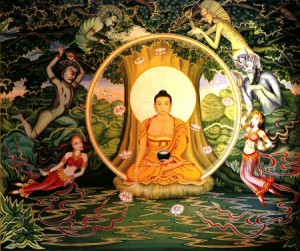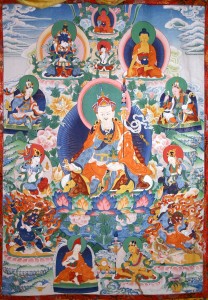The following is an excerpt from a teaching by Jetsunma Ahkon Lhamo called “Neurotic Interaction to Guru Yoga”
Responsibility begins with recognition. Simply that. Recognition. There are some fundamental truths that must be recognized here in order to stop the game of projecting your own neuroses onto yet another external object. Because that is not the practice of Dharma. That is not going to lead you to liberation. That will continue to lead you to more and more neuroses. So you must play the game correctly. The first thing that happens is recognition. It begins with the recognition of the fundamental foundational truth that we call turning the mind toward Dharma—the faults of cyclic existence, cause and effect relationships, impermanence, these kinds of thoughts, and then the realization that in all the six realms of cyclic existence there is suffering. Then the recognition that there is the appearance of the Buddha, which brings the element of enlightenment and supreme realization and the visage or face of our own primordial wisdom nature, and puts that into the world. That’s the Buddha, the Dharma, which is the Buddha’s method, inseparable from the Buddha like the rays are inseparable from the sun, and the result, which is enlightenment, also inseparable from the Buddha. You begin to recognize that this has in fact happened.
In the world there is the Buddha. There is the Dharma. There is the Sangha, and there is the Lama as the condensed essence of all three. That recognition alone puts you into position where you have to choose between continuing in samsara and neurotic redundancy which is what samsara really is. Isn’t that a great term? Neurotic redundancy. Don’t you just love that? Neurotic redundancy,.Or you can choose Buddha, and Dharma, and Sangha—this three-legged stool, or chariot we should say, by which we travel through the door of liberation into enlightenment, into realization, the precious awakened state that the Buddha named.
So we’re in a position now where we make that choice. That choice is based on this recognition. You can’t make that choice on an emotional level. Big mistake! And some people try to do that. They come to the temple and they say, “I like this stuff! It’s all weird. I like the colors. I like the shape. I like the material over there. Look how they built that up there. Isn’t that cute? Those books… You know, I like that they don’t turn this way. I like that they turn this way. It’s so exotic. I think it’s really cool, don’t you? And then all the statues and crystals! Look at this! This is really cool to be with the crystals!” Really I’m describing a silly mindstate, but many students, when they first begin, will come here and say, “Oh this stuff is so cool. I really want to do this. O.K., you’re my teacher.” So on that emotional level, really not much has happened. Or they might come in and have an emotional reaction. I’ve seen that happen too.
In fact, this is another story that you’ll be amazed at. This is an amazing story. A woman once walked into the bookstore. I happened to be there, checking out the earrings as usual! So I was in the bookstore and she turned around. She got immediately who I was. She had never been around Dharma before, knew nothing about Dharma, knew nothing about anything like that and she just was entranced. She was transfixed. She looked at me and then she did three perfect prostrations. Then when she got up she said “I don’t know what that is. I don’t know what I just did.” No idea what happened there, no idea. And then I never saw her again. And she was crying, crying, just like “My teacher. My teacher at last! My teacher!” Crying. Big emotional thing, and I never saw her again.
What happened there was unfortunate. I would call that an obstacle to her practice. She obviously had enough inner purity to remember a former relationship with her teacher. Something bled through and yet the obstacle was that she could only, in that moment of meeting, relate on a purely emotional level. She could not lay down the foundation. She could not make any connecting thought. Really, as beautiful as that story is, it broke my heart that she never came back. It really did. I love you all, but I have to tell you I have many stories about the ones that got away! You see, she could have been very close to me and it broke my heart that she didn’t come back. But what you’re seeing there is just purely an obstacle. She was only able to relate on this emotional level, and really, it’s not that much different from what you see your dog do when your dog barks to go out or sits there looking at the door. It is an immediate emotional hit that you’re just overwhelmed with. It’s not that different from what animals do. But animals can’t practice Dharma, because what’s needed here is to make these connecting thoughts, these cause and effect thoughts, by creating the kinds of awareness and thinking that causes you to move into a deeper level on the path, and causes you to get the lay of the land, to really get what’s going on here.
This is what’s necessary. She was not able to, at that time, to think of the faults of cyclic existence, to think of impermanence and that this opportunity might not come again. She was not able to think “Now that I’ve found my teacher, I have found a way to travel the path of Dharma and pass through the door of liberation.” Just not able to think like that. This is a big obstacle that arose in her path at the same time as the blessing of meeting with her teacher again. So this is the difficulty that we all have, but now we are here and we are in a learning and teaching situation. We’re in a situation where we have time to think. We have the leisure to think. We have the ability to put two and two together, and this is how we have to approach the path. This is how we have to do this.
Copyright © Jetsunma Ahkon Norbu Lhamo. All rights reserved


